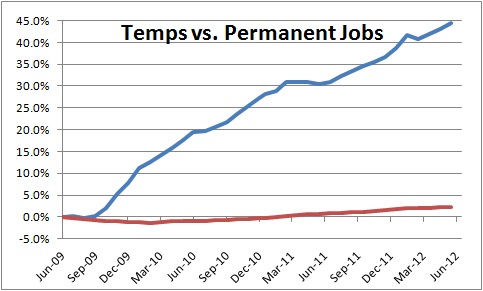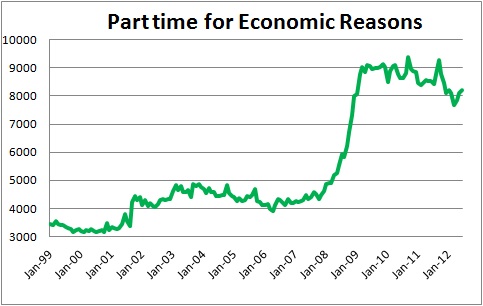July 27, 2012
It has been widely documented that temps are an increasingly important part of the work force today. This appears to be a shrewd business move for companies which can more readily synchronize the size of their work force with the demand for their product. But can these low paid, benefit less workers ultimately undermine corporate morale? And what is the psychological impact on a worker of never knowing how long the current job will last or when the next job might become available?
Since the end of the recession in June 2009 the economy has generated 3.2 million jobs in the private sector. But of those 800 thousand – or 25% of all jobs created — are temps.
In that period of time temp jobs have risen 45%; all other jobs have climbed by just 1.3%.
While temp jobs are still relatively small at just 2.3% of the total jobs market, they are growing quickly and are probably indicative of long-lasting changes that are taking place in the labor market. Keep in mind that the data on “temps”, published by the Labor Department, track job placements by temp agencies, but not temp hiring by individual companies which is likely much larger. Unfortunately, no data are available for this latter category.
The Labor Department also reports that 8.2 million workers are currently working part time for economic reasons, which basically means that no full time position was available. These people want to work full time, but are involuntarily employed part time. These are the ranks of the so-called “underemployed”. Some of these people are currently working for temp agencies, but many more are loosely tied in to the companies for which they work. The number of underemployed workers has declined slightly since the recession ended in June 2009, but it is hard to imagine that it will ever return to its pre-recession level.
Companies stand to benefit from this flexibility. The economy can quickly change speed or even direction, and this gives firms the ability to ratchet upwards their hiring during peak periods, but easily let workers go when activity slows. Furthermore, temps are often paid less than full time workers. They rarely get any benefits like health care or retirement.
Many have the impression that “temps” are low paid, service sector jobs like secretaries, retail clerks, and parking lot attendants. But that is no longer true. Certainly some temps are lower level positions, but now many lawyers and paralegals, accountants, university professors, factory workers, information technology specialists, and even CEO’s and CIO’s can find themselves in such a position.
But one wonders about the longer-term implications of these flexible employment arrangements. Can the existence of hire-and-fire workers actually undermine company morale? These people have absolutely no loyalty to the company for which they work. Does productivity suffer if the worker knows that the job will only exist for a few months? Does uncertainly about the duration of employment and when the next opportunity might come along reduce that family’s willingness to buy a new house or car? Will taxpayers absorb the cost of health insurance for these workers if they choose not to buy it on their own and rely, instead, on emergency room treatment or Medicaid? Will these workers ever be able to save for retirement? The answers to these questions are unknown.
And don’t count on those temp positions becoming permanent. Staffing agency experts indicate that their clients expect only modest growth in employment in the years ahead, with temps accounting for an ever larger portion of the work force. With the unemployment rate hovering just about the 8.0% mark and an ample supply of adequately skilled labor, there is no incentive at the moment for firms to boost permanent hiring. But at some point down the road, perhaps two years from now when the labor market has tightened and the unemployment rate has once again returned to its full employment threshold of 5.5-6.0%, firms will be forced to offer permanent, higher paying jobs with health care, retirement, and vacation benefits. At that point a temp position may be viewed as try-before-you-buy, and those positions will be awarded to the best and the brightest amongst the ranks of the temp workers then being used by that company. Unfortunately, that is not the case currently.
Stephen Slifer
NumberNomics
Charleston, SC




Follow Me